If estimates are fast to send but slow to deliver, you’re leaking margin.
Bottom-up estimating fixes that.
Break work into deliverables, map roles and hours, and price the real effort—then validate against actuals.
Here’s how it works, how it differs from top-down estimating, and how to put it into practice in your firm.
What is bottom-up estimating (and how it complements top-down)
Bottom-up estimating involves breaking deliverables into specific tasks, estimating time and cost per task and role, and using this information to create project totals.
Top-down estimating involves taking a more macro view, determining time and costs based on the high-level project scope.
They’re different, but both are useful.
Think of top-down estimating like a compass: it gives you quick, broad directional guidance. It’s good for rough ballpark numbers in sales calls and early stages where the project is still vague or unclear.
And bottom-up estimating is like a map: it gives detailed, specific guidance to get you from point A to point B. It’s best once the project is confirmed, helping you make sure every project task, deliverable, and cost will be accounted for.
For example, your sales team might estimate $120,000–$140,000 for a brand campaign based on similar past projects (top-down).
Once the client is ready to move forward, your delivery team builds a bottom-up estimate around the campaign’s key deliverables, such as:
- Brand strategy framework — workshops, documentation, and guidelines
- Visual identity system — logo, color palette, and design templates
- Website refresh — homepage, landing pages, and content migration
- Launch campaign assets — social posts, ad creative, and video edits
Each deliverable is then broken into underlying tasks (e.g., concepting, copywriting, QA testing, client review), with time and cost estimated per role.
This gives your team a clear view of what’s included, what it costs, and how each piece contributes to the total project value.
Using both types of estimating helps you match your quoting approach to different pipeline stages.
Top-down estimates help you get conversations started quickly, while bottom-up helps you increase accuracy and transparency once clients are committed.
Why bottom-up is critical for service firms
Bottom-up estimating has three main benefits: accuracy, transparency, and alignment.
- Accuracy: Bottom-up quoting reduces scope creep and margin leakage by creating estimates based on real historical project data (e.g., time-tracking data, “Project list” data in Scoro), not assumptions. It outlines the exact project scope, showing your team and your client what will and won’t be done.
- Transparency: Bottom-up estimates build trust with clients by showing what they’re paying for and why. This creates clear expectations and reduces pushback.
- Alignment: Bottom-up quoting gets delivery, sales, and finance teams on the same page. Understanding exactly what’s included helps prevent miscommunications that stall project progress. Sales knows what they sold. Delivery knows what they’re building. And finance knows the project profitability targets.
How to run bottom-up estimating (step-by-step process)
So, how do you actually approach bottom-up estimating?
Here’s our recommendation:
1. Define outcome-based deliverables
Bottom-up estimates begin with concrete deliverables.
Deliverables should be:
- Client-facing: Visible to the client
- Outcome-based: Provide specific results
- Easy to scope: Be clear on what it does or doesn’t include
As Nelson Brassell, a sales manager at Ten Speed told us,
A good deliverable is something that is simple to understand by a non-marketer, doesn’t have variable cost, and has clear definitions for what it includes (and doesn’t include).
For example, don’t just say “design work, 40 hours.”
That’s too vague: it’s not clear what specific outcomes and tasks that will include.
For example, instead of writing “design work — 40 hours,” which is too vague, break it into outcome-based deliverables the client can recognize.
Like “Brand strategy framework,” “Visual identity system,” “Website refresh,” and “Launch campaign assets.”
In Scoro’s “Quotes” builder, you can add each of these deliverables as its own subheading.
Under each, you can later group related tasks or roles to build an accurate, transparent estimate.
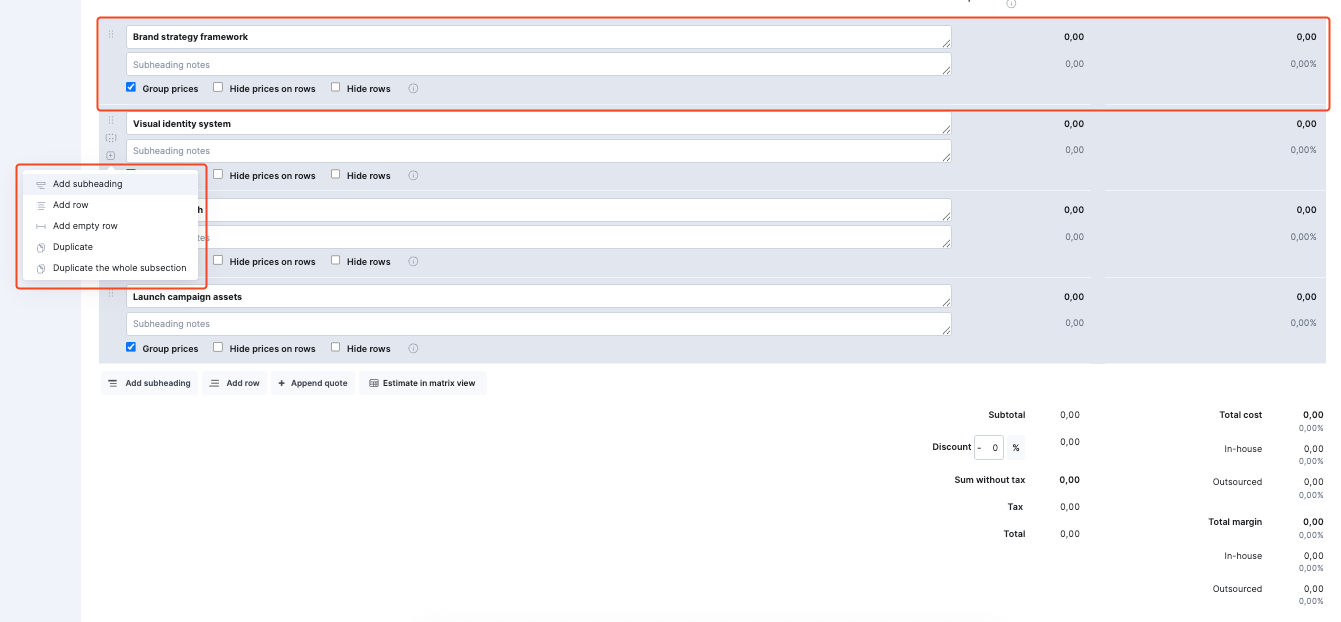
2. Break deliverables into tasks and roles
Next, break each of these concrete deliverables into tasks and roles.
After, you should be able to answer, “What exactly needs to be done and who’s going to do it?”
And before you think this is too “in the weeds” for a quote, remember: granularity creates accuracy. And missing tasks create hidden costs.
Say your deliverable is “Brand strategy framework.”
Underneath that subheading, use rows to list the concrete tasks that make it happen—like stakeholder interviews, positioning workshops, or messaging documentation.
You can easily add new rows in Scoro’s Quote builder to capture each task.
This gives your team full visibility into what’s included, while keeping the client-facing quote clean—you can hide these rows later on if needed.
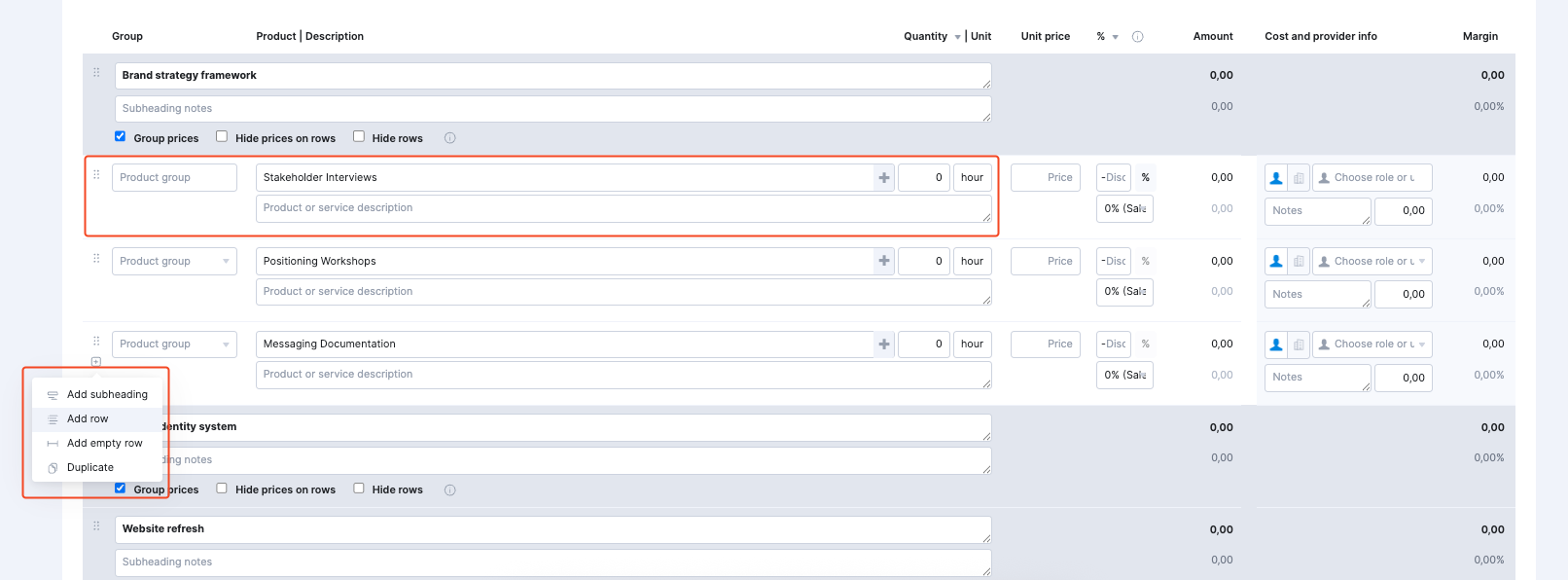
Then, assign a role to each task—such as a Strategy Expert, Senior Consultant, or Copywriter.
At this stage, it’s one role per task, giving you a clear first pass at estimating who’s responsible for what.
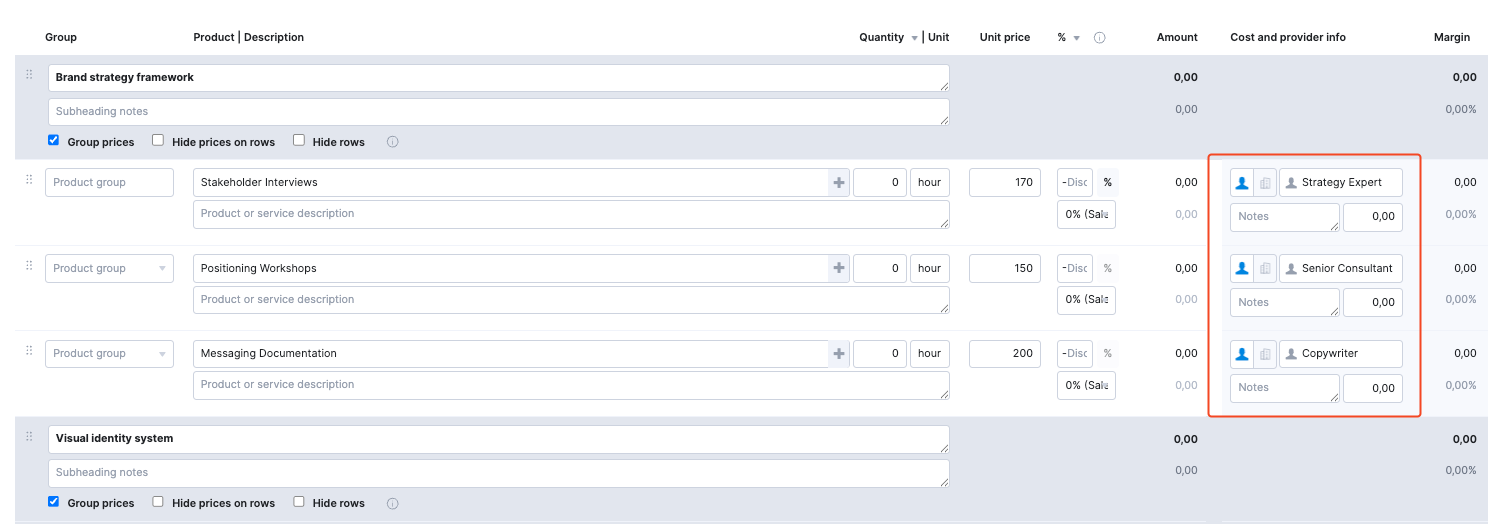
If a task involves multiple team members in the same role—say two Strategy Experts collaborating on a positioning workshop—open Scoro’s matrix view in the Quote builder.
This lets you assign more than one person to a single task and capture the collaboration accurately.
It’s especially useful for workshops, reviews, or strategy sessions where several experts contribute to the same deliverable.
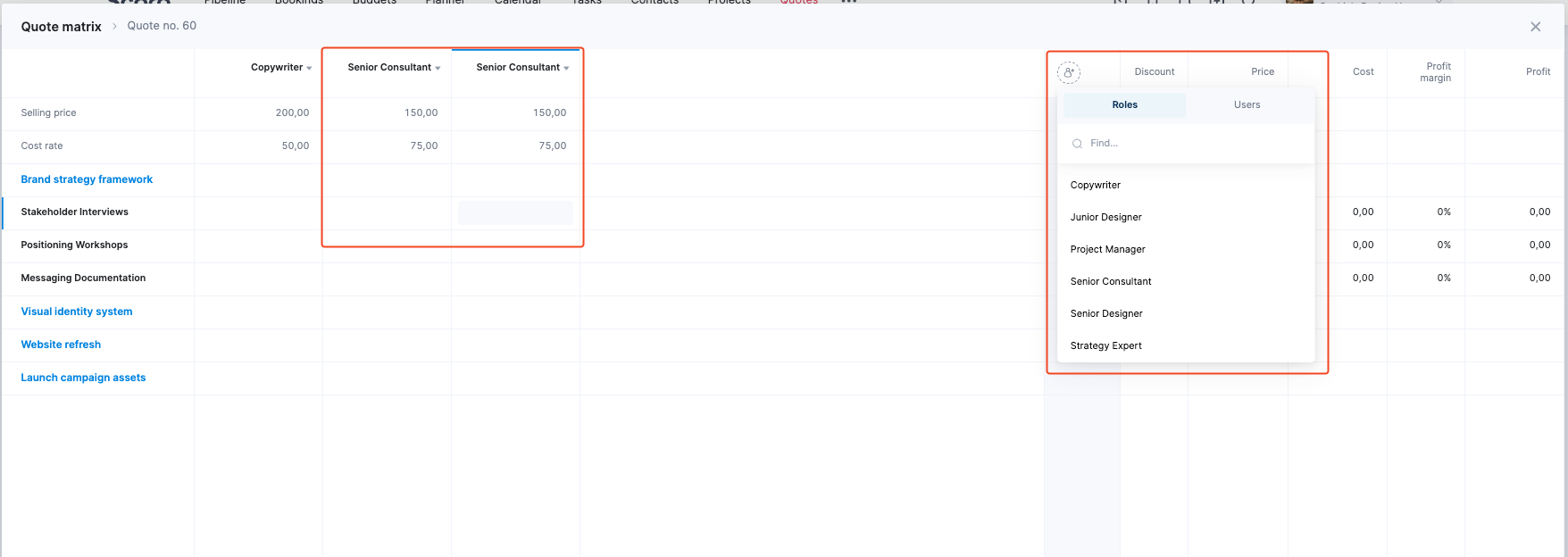
Top Tip
Don’t forget to consider the differences between senior and junior roles. Senior employees may be more expensive per hour, but they can generally get things done faster. Junior hires have lower rates, but might take a bit longer to get the job done.
3. Estimate hours per role
Next, estimate the amount of time each task and role will need.
Start with what you already know:
- Look back at similar past projects and note roughly how long comparable tasks took
- Ask team leads or specialists to sanity-check your assumptions—they usually know where time tends to balloon
- And add a small buffer (10–20%) to account for revisions, feedback rounds, or unexpected blockers
If you’re using Scoro, head to the “Project list” view to find a similar past project.
Then, drill down into “Budget” > “Quoted vs. Actual” to see the initial time estimates for different tasks and deliverables compared with how long they actually took.
This way, you don’t risk underquoting—and cutting into your margins when work takes longer than you planned.
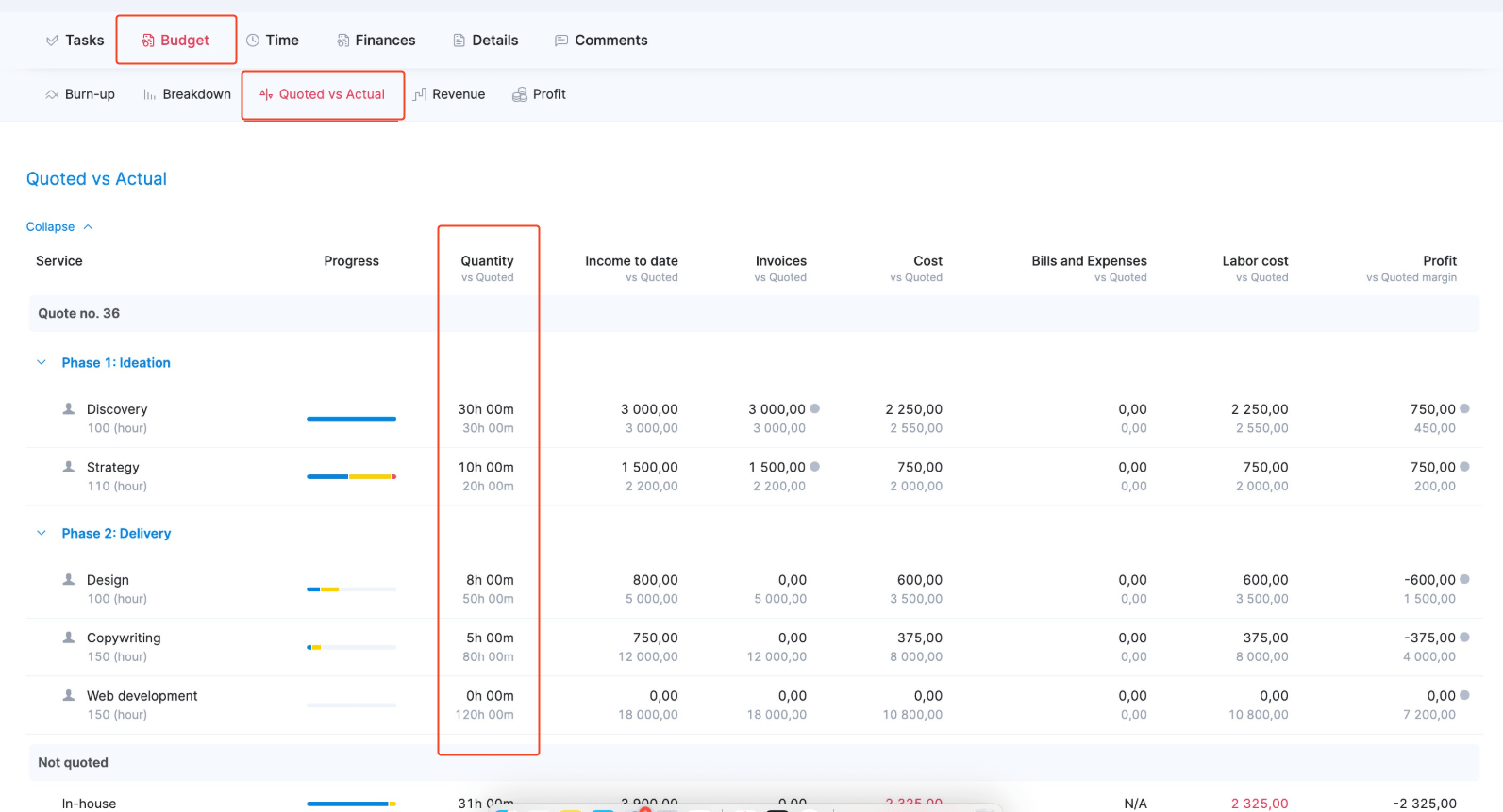
Once you’ve reviewed your data, open the matrix view in Scoro and add your time estimates for each task per role.
Here’s how that might look for a “Brand strategy framework” deliverable:

From here, use the matrix to identify potential tasks that might require additional hours from multiple roles.
For example, if both your designer and project manager need two hours for “client review and revisions,” that’s a real cost that often gets missed in simple, high-level estimates.
Top Tip
If the risk for scope creep is higher—say, if the client requires lots of management, the scope is unclear, or there’s lots of revision rounds—build in additional contingency buffers to protect your margins where it’s likely scope might increase. You might add a 10-20% buffer on each task, or even add a separate hidden row in your quote with a buffer.
4. Calculate total costs
Finally, it’s time to figure out your total costs.
If you’re doing this manually, you’ll need to:
- Multiply the labor rate by the total hours needed for each deliverable to get your deliverable costs
- Add up the deliverable costs to get your final project cost estimate
For example, if your “Brand strategy framework” includes these tasks:
| Task | Role | Hours | Rate $ | Total |
|---|---|---|---|---|
| Stakeholder interviews | Strategy Expert | 12 h | 170 | 2 040 |
| Senior Consultant | 8 h | 150 | 1 200 | |
| Positioning workshops | Strategy Expert | 16 h | 170 | 2 720 |
| Senior Consultant | 10 h | 150 | 1 500 | |
| Messaging documentation | Copywriter | 12 h | 200 | 2 400 |
| Senior Consultant | 4 h | 150 | 600 | |
| Senior Designer | 2 h | 120 | 240 | |
| Strategy Expert | 4 h | 170 | 680 | |
| Internal review & client revisions | Copywriter | 2 h | 200 | 400 |
| Senior Consultant | 2 h | 150 | 300 | |
| Senior Designer | 2 h | 120 | 240 | |
| Strategy Expert | 4 h | 170 | 680 | |
| Total | $13 , 000 (approx.) |
Doing this manually requires careful tracking and spreadsheets to make sure every role, rate, and task adds up correctly.
Scoro’s matrix estimator does this for you automatically. As soon as you enter hours and role rates, Scoro calculates:
- The total price (to the client)
- The total cost (to you)
- The profit margin for each task and deliverable
At the bottom of the view, you’ll also see the aggregate totals across all roles and deliverables. In this example, 78 hours, $13,000 total price, and a 62% profit margin.

Click “Apply” to add everything to your quote.
There, you can see the total cost of all tasks (in rows) and of all deliverables (in subheadings). If you don’t want to show the task breakdown to your client, check “hide rows.”

Once you’ve added all deliverables and their associated tasks, roles, and hours, you’ll see the final project totals in your quote.
In Scoro, this summary automatically aggregates:
- Total cost – the sum of all in-house labor and outsourced work
- Total margin – your profit expressed as a percentage and total amount

Top Tip
If you want tighter control over what gets sent to clients, set up a quote approval flow in Scoro. You can define a value threshold (e.g., all quotes above $50,000) and assign approvers who must review high-value quotes before they’re finalized. This helps prevent unauthorized discounts or overservicing—and keeps your margins protected.
5. Validate and standardize
Finally, validate and standardize your quotes so that you don’t have to repeat this process from scratch every time.
First, validate by connecting your quotes to actual project data. In Scoro, turn confirmed quotes into projects to carry over all estimated hours, tasks, and roles and track time against what was estimated. This way, you can easily:
- Compare quoted hours to actual ones to assess your estimating accuracy
- Compare new projects to past ones to track your average task time and margins
- See trends and where you might make projects more efficient
Then, standardize. Use data from your validated quotes to create templates and predefined services for consistency and accuracy.
For example, you can save your matrix estimates as quote templates in Scoro. From a saved quote, just click “Save as a template.”

Use templates for your most common service options or packages, such as:
- Basic web redesigns
- E-commerce development
- Brand identity packages
- Digital marketing campaigns
And creating standardized individual products, tasks, and services in Scoro helps you build precise bottom-up estimates, faster.

By saving them with relevant cost, time, and provider info, you speed up quoting without compromising accuracy. Just click what you need from the drop-down menu to add it to your proposal.
Tools to streamline bottom-up estimating
Without the right tools, your estimating process can still be manual and time-consuming.
You generally have two options:
1. Spreadsheets. If you’re just getting started and estimating simple projects, spreadsheets aren’t a bad option—they’re quick to set up and free.
But they aren’t connected to anything else (e.g., tracked time, project or resource allocation data), so you have to juggle multiple tools to pull together information for estimates. And as you take on more projects, you’re more likely to accidentally enter incorrect info that’ll throw them off.
2. PSA (professional services automation) or project software. PSA software automatically calculates total hours and costs to create your estimate, reducing manual work and human errors.
It also connects estimates to budgets and project plans. And makes it easy to compare quoted vs. actual hours and costs. This way, you can validate and adjust in the future for more accurate quoting.
With a PSA tool like Scoro, every team involved in quoting can work in the same platform with connected data:
- Sales can create an initial quote using top-down estimating. Since services are standardized and quotes total automatically, this just takes a few minutes to generate a $75,000 estimate with high-level scoping and deliverables.
- A project manager expands the quote with bottom-up estimating to scope detailed deliverables with the matrix estimator. They update the total to $78,000 with detailed notes on the price increase for internal clarity.
- The delivery team converts the confirmed quote into a project. Task lists, resource needs, and project budgets are already set up and linked to the estimate for visibility.
- The finance team can then see estimates vs. actuals, profitability, margin, and burn rates in real time.
This connected workflow means every quote becomes the foundation of a profitable project—not just a number in a spreadsheet.
And if you’ve ever tried managing that process across five different tools, you’ll know how quickly errors and inefficiencies creep in.
That’s exactly what Ryan Pearcy dives into in our conversation on The Handbook: The Operations Podcast—how disconnected systems silently drain time and profit, and what to do about it:
Make accurate scoping and quoting easier
Bottom-up estimating should be a key part of your scoping and quoting process to ensure accurate, profitable quotes.
How do you put it into practice? Start small instead of trying to reinvent your entire workflow:
- Audit your last 10 projects for estimates vs. actual tracked time, and note any areas of consistent underquoting and the average times for common tasks
- Add your most common services to Scoro
- Use Scoro’s matrix estimator to create your first bottom-up template (using a common service as an example)
From there, add a “bottom-up estimating” step to your quoting process to improve accuracy and profitability.
Great quotes that get approved start with great pitches. Learn how to craft pitches that work in our “How to Pitch to Win” episode of The Handbook.
And see how a communications consultancy cut overservicing and improved their profit margins with Scoro’s seamless quoting and project budget and tracking tools.






